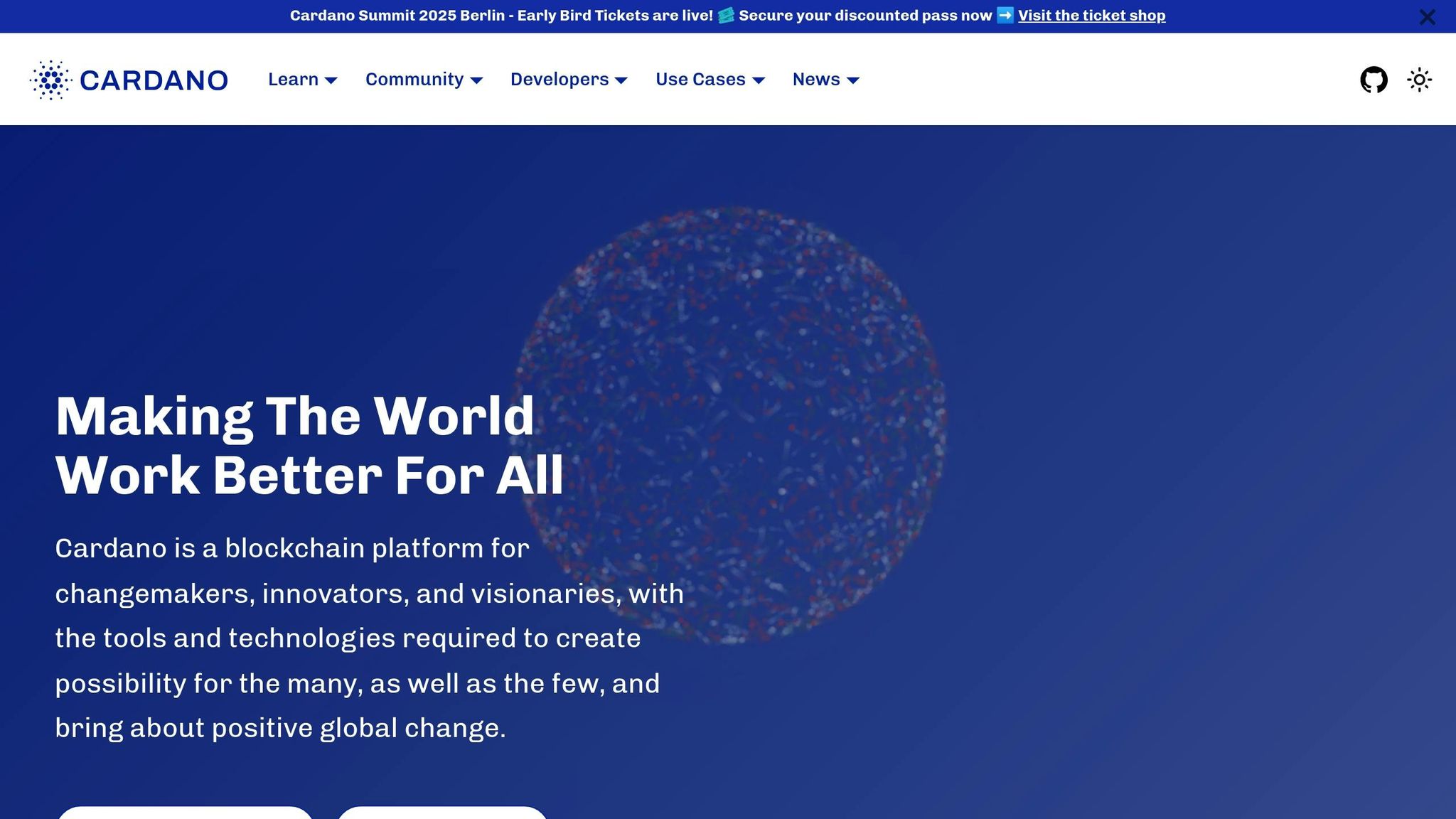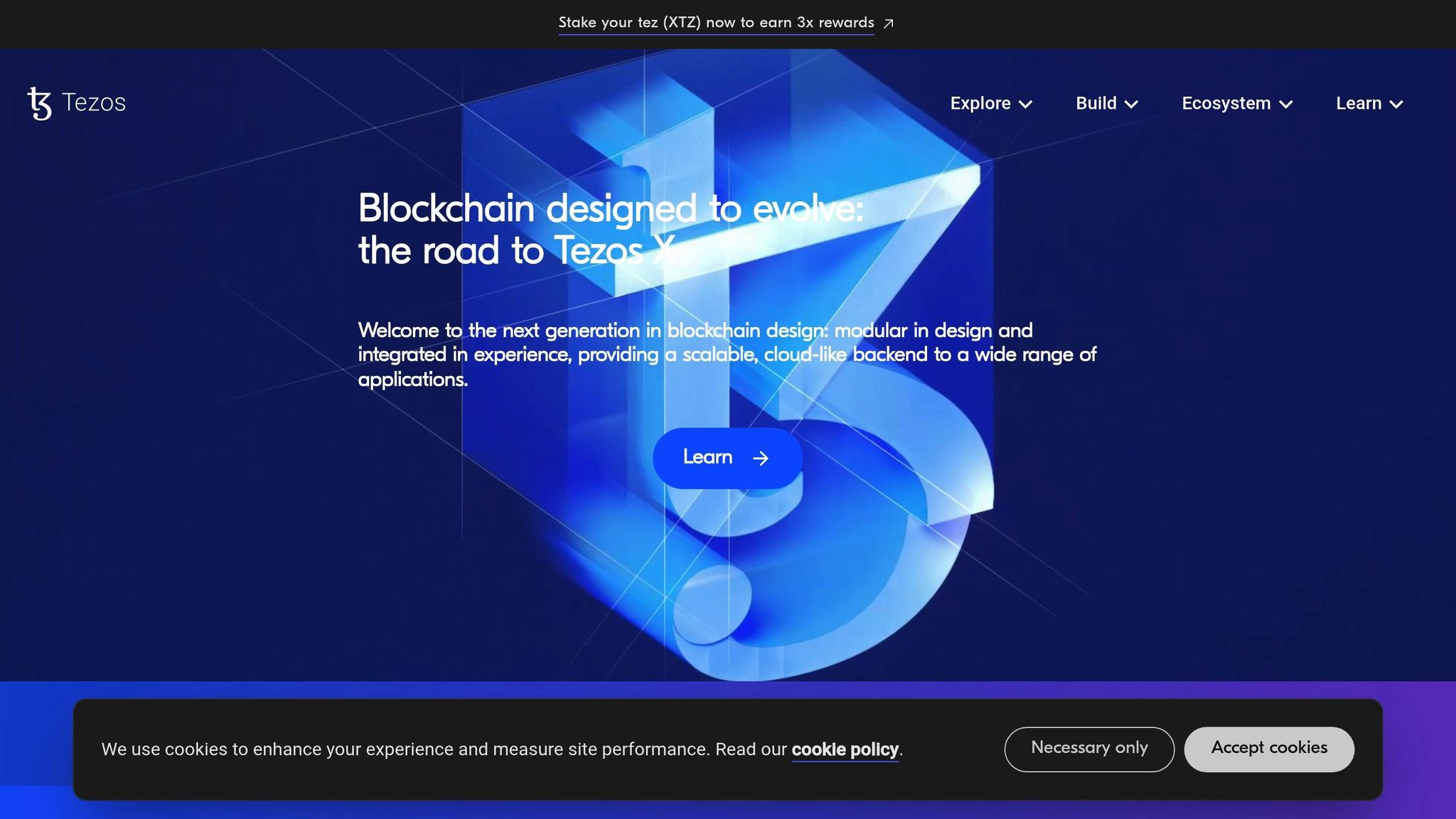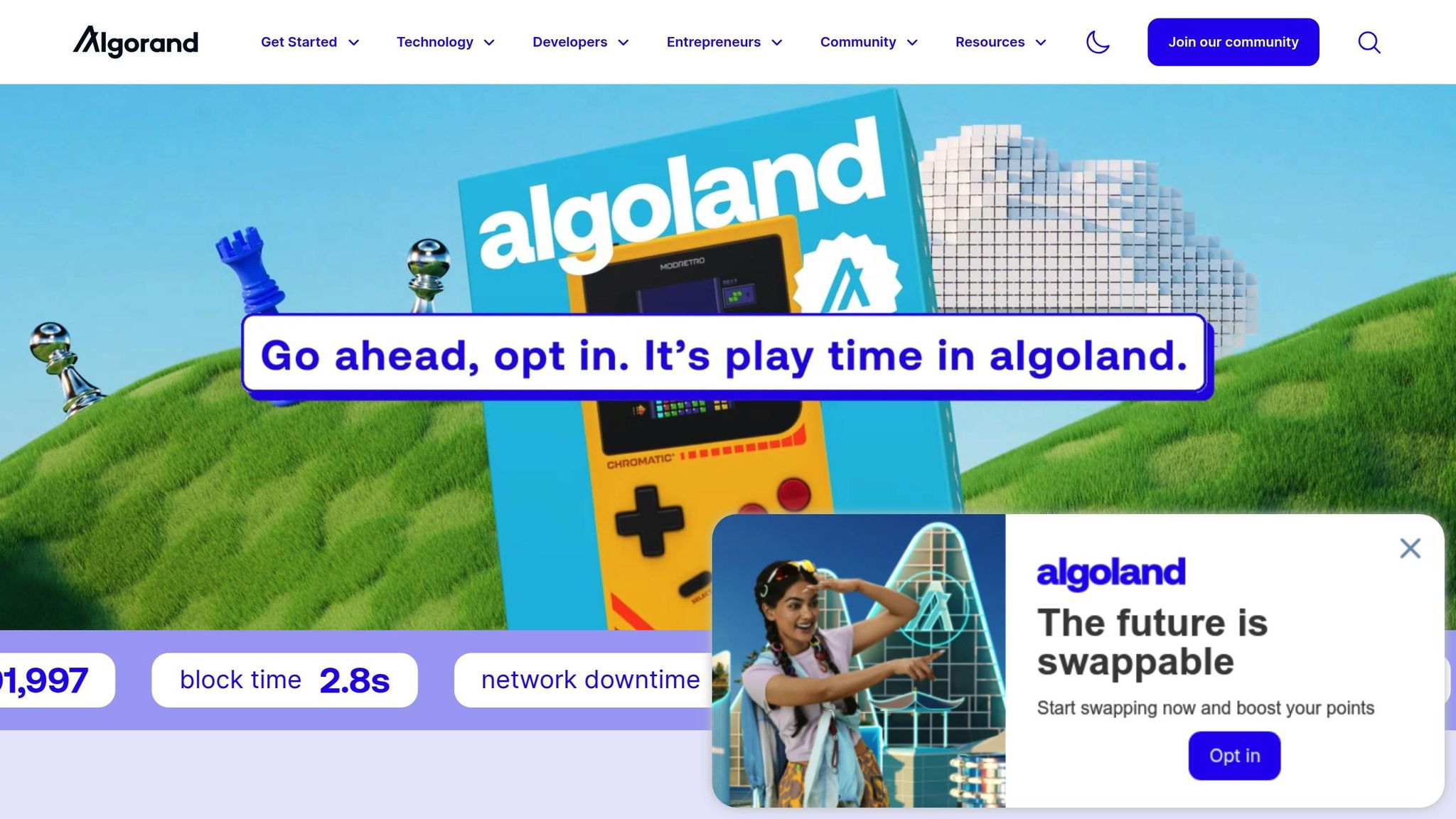Staking reward models determine how blockchain networks incentivize users to secure and validate transactions. These models must balance rewards, inflation, and security to maintain long-term network health. Poorly designed systems can lead to token inflation, reduced trust, or security risks. The key to success lies in:
Managing token supply: Fixed issuance, dynamic adjustments, or capped supply can control inflation and sustain token value.
Aligning user incentives: Reward structures should encourage long-term staking, governance participation, and honest behavior.
Ensuring security and decentralization: Diverse validators, fair penalties, and balanced staking requirements strengthen the network.
Examples like Cardano, Tezos, and Algorand show how tailored approaches to rewards, inflation, and governance can support network stability and growth. Tools like simulation platforms and game-theory models help refine these systems before launch.
Staking Rewards - Math, Examples and Algorithm | DeFi
Core Principles for Designing Staking Reward Models
Creating sustainable staking models requires balancing three key principles to maintain economic stability.
Token Inflation and Supply Management
Managing token supply is at the heart of any staking reward model, and there are several approaches to consider:
Fixed issuance models: These distribute a set number of tokens per period, offering predictability and transparency. Users can easily forecast token supply, reducing speculation fueled by uncertainty.
Dynamic issuance models: Here, token creation adjusts based on factors like staking participation or validator performance. While this approach keeps individual reward rates more stable, it adds complexity when predicting total supply growth. Parameters must be carefully set to meet network needs without causing volatility.
Capped supply models: By setting a maximum token limit, these models eliminate concerns about long-term inflation. Rewards come from transaction fees or a token reserve instead of new issuance. While this appeals to users worried about dilution, careful planning is crucial to ensure rewards remain sufficient as the network grows and transaction volumes fluctuate.
The choice between these models depends on the network's goals. For instance, networks focused on preserving long-term value often prefer capped models, while those aiming for rapid adoption may lean toward controlled inflation to fund rewards.
But managing supply is just one part of the equation - aligning user behavior is equally important.
User Incentives and Network Alignment
A successful staking model isn’t just about offering attractive returns; it’s about creating long-term value for both users and the network.
Reward structures for longer staking periods: Rewards that favor extended staking reduce token velocity and encourage stable participation. For example, slightly higher rates for longer lock-up periods can reward committed users while minimizing market volatility.
Governance integration: Linking stake duration to voting power aligns user decisions with the network’s long-term health. This discourages proposals that prioritize short-term gains at the cost of sustainability.
Progressive rewards: Offering modest bonuses for longer commitments can encourage desired behaviors without creating unsustainable pressures. The key is to strike a balance so users don’t feel forced into lock-ups beyond their comfort level.
Penalty mechanisms: Penalties, like slashing, deter harmful actions. These must be predictable and proportional - severe enough to discourage bad actors but not so harsh that honest participants fear unexpected losses. Graduated penalties, which differentiate between minor errors and major infractions, help ensure fairness.
Ultimately, these incentives need to work hand-in-hand with robust security measures to safeguard the network.
Security and Decentralization
A secure staking system ensures that honest participation is always more rewarding than attempting an attack. Several factors play into this:
Validator diversity: Reward models should avoid concentrating power among large validators, as this undermines decentralization. Delegation systems can help smaller token holders participate while maintaining a diverse validator set.
Geographic and operational diversity: Encouraging a broad distribution of validators strengthens the network against coordinated attacks or localized infrastructure failures. While reward models can’t dictate validator locations, they can avoid creating economic pressures that favor specific regions or setups.
Minimum stake levels: Setting a reasonable minimum stake discourages cheap attacks while ensuring smaller validators aren’t excluded. The ideal level depends on token distribution and the technical demands of running a validator.
Slashing parameters: These must balance deterrence and fairness. Penalties should be severe enough to discourage attacks but not so harsh that they punish honest validators for technical issues. Graduated penalties, which distinguish between minor and major infractions, help maintain this balance.
Frameworks and Tools for Optimizing Staking Rewards
Creating staking models that can stand the test of time requires thorough testing, often using simulation platforms and game-theory-based tools. As mentioned earlier, finding the right balance between token supply and user incentives is no easy task, but these tools are specifically designed to tackle that challenge.
Simulation Platforms for Testing Models
Dynamic simulation platforms are invaluable for testing staking models before they go live. These platforms help project teams stress-test different scenarios, revealing potential weaknesses that could disrupt network stability. For instance, Tokenomics.net provides simulation services that allow projects to visualize how their staking models might function across various conditions. By running these extended operational scenarios in quick cycles, teams can fine-tune their models to ensure they hold up over the long haul. To complement these simulations, game-theoretic tools add another layer of refinement to incentive structures.
Using Game-Theoretic Models
Game-theoretic frameworks take a closer look at how participants interact within a staking system. These tools simulate the behaviors of rational actors responding to different incentive designs, uncovering patterns and behaviors that might otherwise go unnoticed. By exposing these dynamics, teams can adjust reward mechanisms to promote stability and efficiency in the network.
Case Studies of Successful Staking Reward Models
Now that we've covered the framework for staking models, let's look at how some blockchain networks have successfully put these ideas into action. These examples highlight how different networks have tackled the tricky balance between rewards, security, and long-term stability. Each case offers valuable insights for those building in the Web3 space.
Cardano: Incentives That Promote Decentralization

Cardano's Ouroboros Proof-of-Stake protocol is a great example of how a well-thought-out reward system can encourage both broad participation and decentralization. The protocol uses a controlled inflation model, ensuring predictable token issuance, which brings stability to both validators and delegators.
One standout feature of Cardano is its delegation mechanism. ADA holders can delegate their tokens to stake pools without locking them up or giving up ownership. This flexibility encourages more users to participate, spreading stake across the network. To avoid any single pool becoming too powerful, the system caps pool sizes and ensures rewards are shared transparently between pool operators and delegators.
Tezos: Linking Rewards to Governance

Tezos takes a unique approach by tying staking rewards directly to governance. Its Liquid Proof-of-Stake system requires validators, known as bakers, to participate not just in block production but also in governance decisions. This means rewards are earned through active contributions to the network's evolution.
The network funds staking rewards through an inflationary model and includes a self-amending protocol for on-chain upgrades. Bakers are incentivized to vote on proposals, with active participation leading to better rewards. To ensure commitment, bakers must bond a minimum amount of XTZ, and reward fees are structured to maintain balance within the ecosystem.
Algorand: Combining Fixed Supply with Governance Incentives

Algorand addresses token inflation concerns with its Pure Proof-of-Stake protocol, which prioritizes predictability and sustainability. The network has a capped total supply of ALGO tokens and follows a predetermined release schedule, avoiding the pitfalls of unchecked inflation.
Initially, ALGO holders received staking rewards, but the network has since shifted to governance-based incentives to encourage active participation. Validators are chosen using a verifiable random function, which supports decentralization without requiring large minimum stakes. With features like immediate transaction finality and low fees, Algorand offers a practical model for long-term network growth.
These examples showcase different ways to design effective staking systems. Cardano focuses on decentralization through flexible delegation and controlled token issuance. Tezos ties rewards to governance, ensuring that contributors play an active role in network upgrades. Algorand, meanwhile, combines a fixed token supply with governance incentives for a stable and predictable ecosystem. Together, these models highlight the importance of balancing rewards, inflation, and security to build sustainable blockchain networks.
Best Practices for Staking Reward Models
Creating a sustainable staking reward model is no simple task - it requires careful consideration of interconnected elements. From studying various successful networks, it's clear that three factors are key: controlled inflation, meaningful user incentives, and strong network security. Every decision in one area inevitably affects the others, so it’s crucial to approach the design process with a well-rounded perspective.
The most successful staking models tend to follow a few common principles. They offer predictable reward structures that users can easily understand and plan around, while still allowing for flexibility as the network evolves. Additionally, they establish clear incentives that encourage behaviors essential for the network’s health, such as widespread participation, active governance, or long-term commitment.
Key Takeaways for Web3 Founders
For Web3 founders, these takeaways focus on inflation control, incentive design, and security - core principles for building a strong staking framework.
Develop a sound inflation strategy: Whether you opt for a fixed supply model like Algorand or a controlled inflation approach like Cardano, ensure your strategy aligns with long-term token value and network growth. Keep in mind that unchecked inflation can undermine user trust and engagement.
Craft incentives to drive desired behaviors: Your incentive structure should reflect the priorities of your network. For instance, if decentralization is your goal, design mechanisms to avoid stake concentration. If governance participation is critical, tie rewards to voting activity, as seen in Tezos. Incentives should motivate actions that strengthen the network.
Prioritize security from the start: A robust reward model must make attacking the network costlier than participating honestly. This involves setting appropriate minimum staking amounts, defining slashing conditions, and establishing validator requirements that protect the network without discouraging participation. Be sure to combine these safeguards with regular testing to ensure your model’s resilience.
Lastly, don’t rely solely on theoretical designs. Test your assumptions early and often, as real-world performance may differ significantly from what’s on paper. Incorporate mechanisms to adapt your model based on live data.
Leveraging Tools Like Tokenomics.net

To refine your staking model, professional tools and expertise can make a big difference. Platforms like Tokenomics.net offer dynamic simulations and consulting services to test various reward structures, inflation schedules, and participation scenarios. These tools help identify potential issues before deployment, ensuring your model is optimized and giving you a stronger case when seeking investment.
FAQs
What are the differences between fixed, dynamic, and capped token supply models, and which one best supports long-term network stability?
Fixed supply models set a hard cap on the total number of tokens, ensuring that no additional tokens can ever be created. This approach helps maintain token value by preventing inflation. However, it can also pose challenges - if demand significantly increases over time, the limited supply might hinder further growth.
Dynamic supply models, on the other hand, are more flexible. They adjust the number of tokens issued based on market conditions. This flexibility can help stabilize inflation and encourage growth. But there’s a catch: poor management of these models can result in excessive inflation, which risks eroding trust in the system.
Capped supply models strike a middle ground. They allow for token issuance but set a strict maximum cap over time. This method aims to balance growth with stability, offering a framework that promotes long-term trust and predictability within the network.
What are the risks and benefits of tying staking rewards to governance participation?
Tying staking rewards to governance participation is a smart way to boost community engagement while strengthening network security. By rewarding those who actively take part in decision-making, this system ensures that incentives are aligned with the ecosystem's long-term well-being.
But it's not without challenges. When voting power becomes concentrated among a small group, there's a risk of centralization and even governance manipulation. On top of that, locking tokens for governance purposes can restrict liquidity, exposing assets to market volatility during the lockup period.
The real challenge lies in finding the right balance - encouraging active participation without opening the door to these potential pitfalls. A well-thought-out staking reward model can make all the difference.
How can blockchain networks balance decentralization and security in their staking reward models to encourage validator diversity?
Blockchain networks achieve a balance between decentralization and security by crafting staking reward systems that encourage a wide, geographically diverse group of validators. This approach minimizes the dangers of centralization and helps the network withstand local disruptions.
Effective reward models should provide fair compensation to validators based on their contributions while implementing penalties to deter harmful activities. By aligning rewards with the long-term well-being of the ecosystem, these networks can create a secure, decentralized framework that promotes steady and reliable growth.







